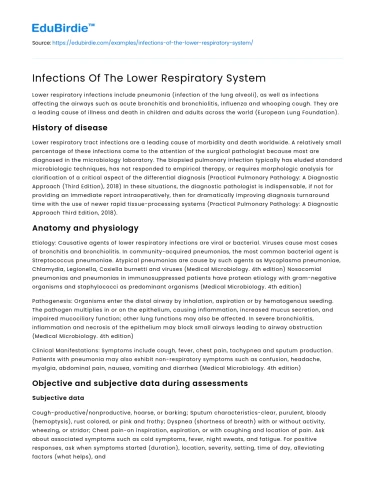Lower respiratory infections include pneumonia (infection of the lung alveoli), as well as infections affecting the airways such as acute bronchitis and bronchiolitis, influenza and whooping cough. They are a leading cause of illness and death in children and adults across the world (European Lung Foundation).
History of disease
Lower respiratory tract infections are a leading cause of morbidity and death worldwide. A relatively small percentage of these infections come to the attention of the surgical pathologist because most are diagnosed in the microbiology laboratory. The biopsied pulmonary infection typically has eluded standard microbiologic techniques, has not responded to empirical therapy, or requires morphologic analysis for clarification of a critical aspect of the differential diagnosis (Practical Pulmonary Pathology: A Diagnostic Approach (Third Edition), 2018) In these situations, the diagnostic pathologist is indispensable, if not for providing an immediate report intraoperatively, then for dramatically improving diagnosis turnaround time with the use of newer rapid tissue-processing systems (Practical Pulmonary Pathology: A Diagnostic Approach Third Edition, 2018).
Save your time!
We can take care of your essay
- Proper editing and formatting
- Free revision, title page, and bibliography
- Flexible prices and money-back guarantee
Anatomy and physiology
Etiology: Causative agents of lower respiratory infections are viral or bacterial. Viruses cause most cases of bronchitis and bronchiolitis. In community-acquired pneumonias, the most common bacterial agent is Streptococcus pneumoniae. Atypical pneumonias are cause by such agents as Mycoplasma pneumoniae, Chlamydia, Legionella, Coxiella burnetti and viruses (Medical Microbiology. 4th edition) Nosocomial pneumonias and pneumonias in immunosuppressed patients have protean etiology with gram-negative organisms and staphylococci as predominant organisms (Medical Microbiology. 4th edition)
Pathogenesis: Organisms enter the distal airway by inhalation, aspiration or by hematogenous seeding. The pathogen multiplies in or on the epithelium, causing inflammation, increased mucus secretion, and impaired mucociliary function; other lung functions may also be affected. In severe bronchiolitis, inflammation and necrosis of the epithelium may block small airways leading to airway obstruction (Medical Microbiology. 4th edition)
Clinical Manifestations: Symptoms include cough, fever, chest pain, tachypnea and sputum production. Patients with pneumonia may also exhibit non-respiratory symptoms such as confusion, headache, myalgia, abdominal pain, nausea, vomiting and diarrhea (Medical Microbiology. 4th edition)
Objective and subjective data during assessments
Subjective data
Cough-productive/nonproductive, hoarse, or barking; Sputum characteristics-clear, purulent, bloody (hemoptysis), rust colored, or pink and frothy; Dyspnea (shortness of breath) with or without activity, wheezing, or stridor; Chest pain-on inspiration, expiration, or with coughing and location of pain. Ask about associated symptoms such as cold symptoms, fever, night sweats, and fatigue. For positive responses, ask when symptoms started (duration), location, severity, setting, time of day, alleviating factors (what helps), and aggravating factors (what makes it worse). In addition, ask about smoking history, environmental exposure, past medical and family history, and current medications (Bickley, 2012; Mansen & Gabiola, 2015).
Objective data
Visual inspection begins with observation of facial expression, skin color, moisture, and temperature. Skin should be warm and dry, and skin color should be uniform and consistent with ethnicity. Facial expression should be relaxed, without signs of distress or apprehension. Any indication that breathing is a conscious effort may be a sign that something is wrong. Observe nail beds, lips, mouth, ears, and conjunctiva for oxygen saturation. A bluish color indicates cyanosis and hypoxia. Clubbing of the fingers may indicate chronic hypoxemia. Observe the neck for contraction of the sternomastoid muscles; any use of neck muscles to breathe signals difficult breathing (Bickley, 2012; Mansen & Gabiola, 2015).
Signs and symptoms
LRTIs can sometimes become more severe, leading to pneumonia, bronchitis, or other more serious infections. Signs and symptoms include;
- Fever
- Severe cough
- Rapid breathing or difficulty breathing
- Wheezing
- Skin turning a blue color due to lack of oxygen
- Chest pain or tightness (temple lung center)
Diagnosis
There are several tests your doctor may perform if LRTI is suspected:
Pulse Oximetry: this test uses a small sensor that attaches to the finger or ear. It uses light to estimate how much oxygen is present in the blood.
Chest X-ray: creates an image of the lungs. Doctors can visually inspect this image for signs of pneumonia.
Blood Test: a sample of blood is taken and inspected in a laboratory for the presence of viruses, bacteria, or other organisms.
Laboratory Tests: a sample of sputum or mucus is taken and inspected in a laboratory for the presence of bacterial organisms (Temple lung center)
Medical management
Since most LRTIs are viral, medications are generally not used in treatment. However, certain over-the-counter medicines may provide some relief from symptoms:
- Nonsteroidal anti-inflammatory drugs (NSAIDs), such as ibuprofen, naproxen, or aspirin can relieve pain and fever
- Acetaminophen can also provide relief from pain and fever
- Using a bronchodilator inhaler can help wheezing and shortness of breath
If an LRTI is bacterial, antibiotics may be prescribed, depending on how serious the infection is and your overall health. These treat the bacterial cause of the infection (Temple lung center 2018)
Socio-economic factors
Numerous studies indicate that a major health problem in children are illnesses of the respiratory system. Currently, increased attention is being paid to family social conditions and environmental factors in the pathogenesis of these illnesses. Acute respiratory infections are a leading cause of mortality among children under five years of age. In low and middle-income countries, 6.9 million children died in 2011 and about one in five of these deaths was caused by an acute lower respiratory infection (ALRI) (Arch Public Health. 2016; 74: 19.). ALRI is characterized by cough accompanied by short, rapid breathing that is chest-related, and is commonly linked to death through co-morbidities with other childhood illnesses. Ninety-seven percent of ALRI cases occur in the developing world with seventy percent of those cases occurring in south Asia and sub-Saharan Africa alone (Arch Public Health. 2016; 74: 19.)






 Stuck on your essay?
Stuck on your essay?

